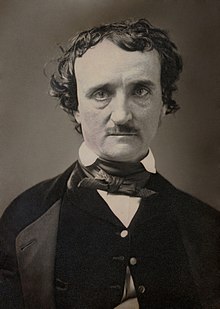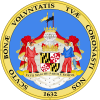Portal:Maryland
|
Maryland Portal
|
Baltimore Task Force
|
Frederick Task Force
|
Montgomery Task Force
|
WikiProject Maryland
|
|
Main page
|
Discussion
|
Introduction Maryland (US: /ˈmɛrɪlənd/ MERR-il-ənd) is a state in the Mid-Atlantic region of the United States. It borders Virginia to its south, West Virginia to its west, Pennsylvania to its north, Delaware and the Atlantic Ocean to its east, and the national capital of Washington, D.C. to the southwest. With a total area of 12,407 square miles (32,130 km2), Maryland is the ninth-smallest state by land area, and its population of 6,177,224 ranks it the 19th-most populous state and the fifth-most densely populated. Maryland's capital is Annapolis, and the most populous city is Baltimore. Maryland's coastline was first explored by Europeans in the 16th century. Prior to that, it was inhabited by several Native American tribes, mostly the Algonquian peoples. As one of the original Thirteen Colonies, Maryland was founded by George Calvert, 1st Baron Baltimore, a Catholic convert who sought to provide a religious haven for Catholics persecuted in England. In 1632, Charles I of England granted Lord Baltimore a colonial charter, naming the colony after his wife, Henrietta Maria. In 1649, the Maryland General Assembly passed an Act Concerning Religion, which enshrined the principle of toleration. Religious strife was common in Maryland's early years, and Catholics remained a minority, albeit in greater numbers than in any other English colony. Maryland's early settlements and population centers clustered around waterways that empty into the Chesapeake Bay. Its economy was heavily plantation-based and centered mostly on the cultivation of tobacco. Demand for cheap labor from Maryland colonists led to the importation of numerous indentured servants and enslaved Africans. In 1760, Maryland's current boundaries took form following the settlement of a long-running border dispute with Pennsylvania. Many of its citizens played key political and military roles in the American Revolutionary War. Although it was a slave state, Maryland remained in the Union during the American Civil War, and its proximity to Washington D.C. and Virginia made it a significant strategic location. After the Civil War ended, Maryland took part in the Industrial Revolution, driven by its seaports, railroad networks, and mass immigration from Europe. Since the 1940s, the state's population has grown rapidly, to approximately six million residents, and it is among the most densely populated U.S. states. As of 2015[update], Maryland had the highest median household income of any state, owing in large part to its proximity to Washington, D.C., and a highly diversified economy spanning manufacturing, retail services, public administration, real estate, higher education, information technology, defense contracting, health care, and biotechnology. Maryland is one of the most multicultural states in the country; it is one of the six states where non-Whites compose a majority of the population, with the fifth-highest percentage of African Americans, and high numbers of residents born in Africa, Asia, Central America, and the Caribbean. The state's central role in U.S. history is reflected by its hosting of some of the highest numbers of historic landmarks per capita. (Full article...) This is a Featured article, which represents some of the best content on English Wikipedia..
Edgar Allan Poe (né Edgar Poe; January 19, 1809 – October 7, 1849) was an American writer, poet, editor, and literary critic who is best known for his poetry and short stories, particularly his tales involving mystery and the macabre. He is widely regarded as one of the central figures of Romanticism and Gothic fiction in the United States, and of early American literature. Poe was one of the country's first successful practitioners of the short story, and is generally considered to be the inventor of the detective fiction genre. In addition, he is credited with contributing significantly to the emergence of science fiction. He is the first well-known American writer to earn a living by writing alone, which resulted in a financially difficult life and career. Poe was born in Boston. He was the second child of actors David and Elizabeth "Eliza" Poe. His father abandoned the family in 1810, and when Eliza died the following year, Poe was taken in by John and Frances Allan of Richmond, Virginia. They never formally adopted him, but he lived with them well into young adulthood. Poe attended the University of Virginia, but left after only a year due to a lack of money. He frequently quarreled with John Allan over the funds needed to continue his education as well as his gambling debts. In 1827, having enlisted in the United States Army under the assumed name of Edgar A. Perry, he published his first collection, Tamerlane and Other Poems, which was credited only to "a Bostonian". Poe and Allan reached a temporary rapprochement after the death of Allan's wife Frances in 1829. However, Poe later failed as an officer cadet at West Point, declared his intention to become a writer, primarily of poems, and parted ways with Allan. (Full article...) General imagesIn the news
On this day...This is a Good article, an article that meets a core set of high editorial standards.
The 1886 Navy Midshipmen football team represented the United States Naval Academy in the 1886 college football season. The team marked the second time that the school played a multiple-game season. The squad was captained by halfback Clarence Stone. The year began with consecutive wins over rivals St. John's College and Johns Hopkins, but then regressed with a loss to the former and a close victory over the latter. The year concluded with shutout losses to the Princeton reserve squad and Gallaudet. The season was the program's longest until 1890, when that year's team played seven games. (Full article...) Selected article -Adamstown is an unincorporated community and census-designated place (CDP) in Frederick County, Maryland, United States. It is named for Adam Kohlenberg (March 11, 1819 – January 1, 1868), a station agent and first town merchant who owned much of present-day Adamstown. As of the 2010 census, the Adamstown CDP had a population of 2,372. (Full article...) Did you know?

SubcategoriesSelect [+] to view subcategories
TopicsRelated portalsAssociated WikimediaThe following Wikimedia Foundation sister projects provide more on this subject:
Discover Wikipedia using portals |
























































